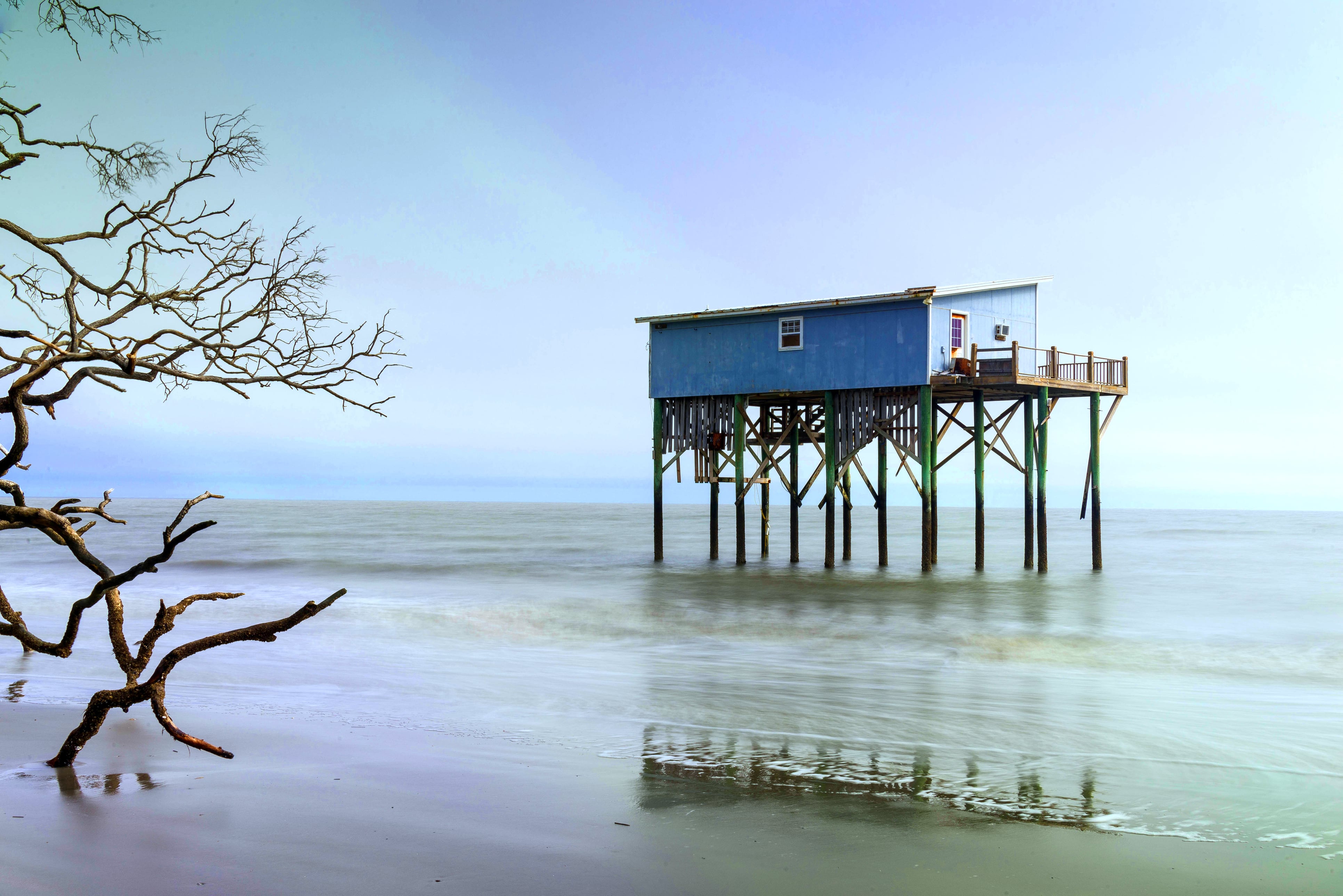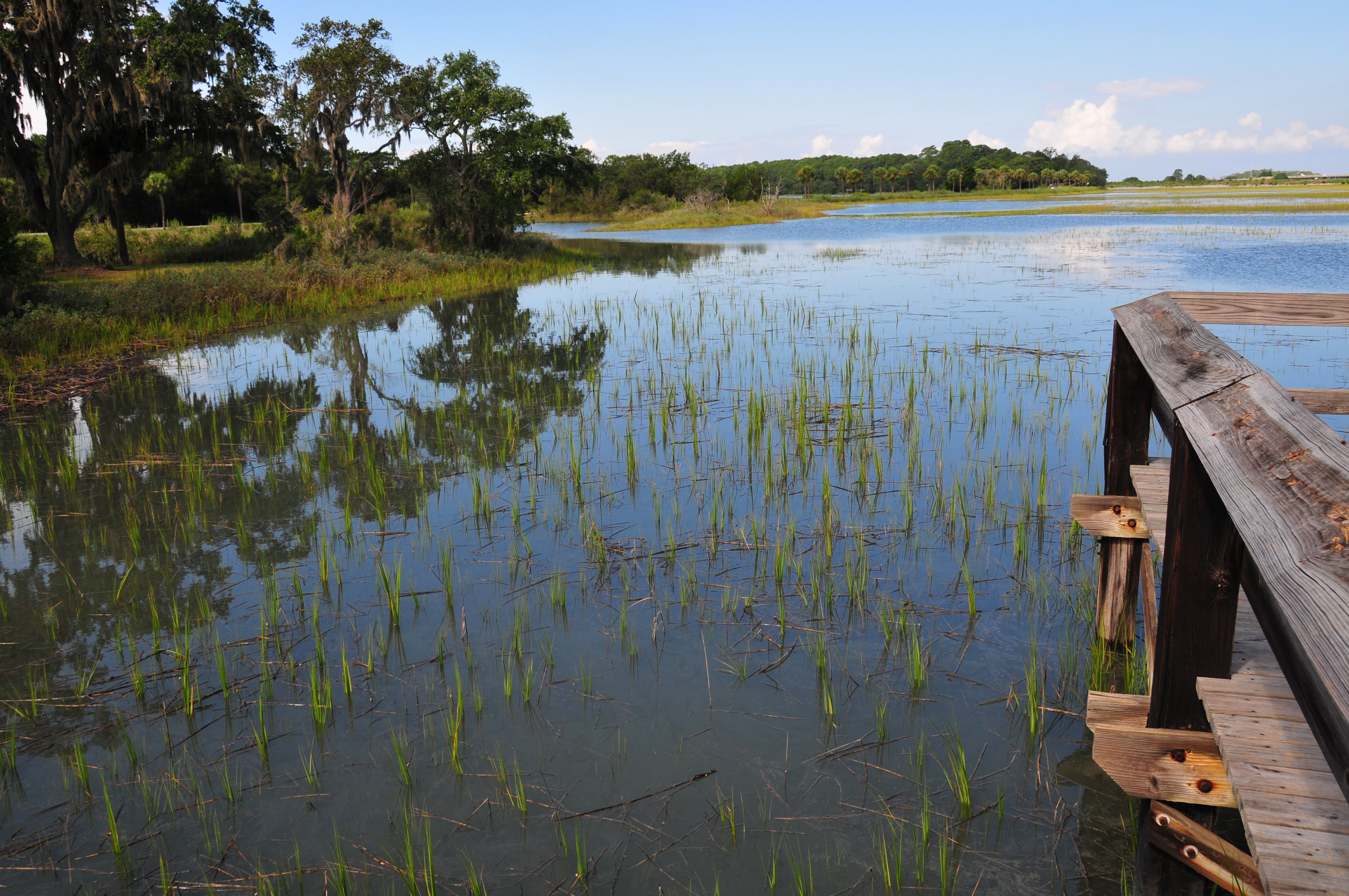There is nothing visible to suggest that Marine Corps Recruit Depot on Parris Island, South Carolina, is in peril.
Rows of quaint pastel painted clapboard cottages and white-picket fences, military housing, line the main road into base. Young recruits, rifles in hand, often quietly train on the mowed lawns near the base’s history museum.
Even a pandemic did not halt training for too long, as the base learned to “adapt and overcome” with new procedures and protocols to try to keep budding Marines from catching COVID-19.
Traditionally, a visit to the 105-year-old depot — hallowed ground to Marines both active and retired — brings with it a sense of weighted history. The approach begins on a narrow, two-lane, earthen causeway connecting the edge of the tiny hamlet of Port Royal, South Carolina, to the base’s guarded entrance. An early morning drive to the marsh-encircled island showed a road sitting barely a few feet above the water at low tide.
“It’s the only roadway on or off the island,” then-Beaufort, South Carolina, Mayor Bill Keyserling told Marine Corps Times in an exclusive interview in 2019.
The water lapping at the grassy lined causeway has been a concern to several people Marine Corps Times has spoken with.
Former Marine Corps Assistant Commandant Gen. Glenn M. Walters, now retired, first raised the alarm at a Senate Armed Services Committee readiness hearing in early 2018 by informing the committee that floodwaters at Parris Island, South Carolina, were the Marines’ greatest threat to military readiness.
He also stated he was privy to several Department of Defense and intelligence briefs that led him to believe it was not a matter of if the base would flood, but when.
At the time, Walters was a rare and candid military voice regarding a scenario often linked to climate change, a topic that was then, more so than now, fraught with political and logistical implications. Walters retired soon after his statements.
The Union of Concerned Scientists, a Washington, D.C.-based think tank of climate scientists, predicted in 2016 that due to rising tides the famed Marine training post could likely experience seas projected to rise between 4 feet and 6.4 feet by the end of the century.
More worrisome, in a worst-case scenario, in less than 30 years the base could be underwater more than a quarter of a year.

“Tidal flooding affects low-lying locations around MCAS Beaufort and MCRD Parris Island, including extensive wetland areas, 10 times per year on average,” the group’s 2016 case study said. “By 2050, the currently flood-prone areas within both bases could experience tidal flooding more than 300 times —annually and be underwater nearly 30 percent of the year given the highest scenario.”
Despite reports of danger to the base, a seawall has not been in the plans for the Marine Corps.
The military budgets for fiscal years 2018, 2019 and 2020 show no requests for federal funding to begin plans or construction of floodwalls to protect the island. Military construction funds for Navy and Marine Corps projects in the fiscal 2021 appropriations bill, signed into law in December 2020, total $1.7 billion but do not include a specific line item that mentions a seawall or water intrusion mitigation plan for Parris Island.
Parris Island has said it has its own contingency plan.
The depot’s official line on readiness?: “We continue our mission of making Marines while remaining prepared to respond to a potential significant weather event,” Capt. Bryan A. McDonnell, spokesman for Marine Corps Recruit Depot Parris Island, said in 2019.
“If an evacuation was deemed necessary, we are well trained in the procedure and have an established evacuation site at Albany, Georgia, where recruit training can continue with minimal disruptions,” he said.
Inquiries to the Marine headquarters near the nation’s capital resulted in a similar response.
“There are no plans to build a seawall at Parris Island,” spokesman Capt. Joseph Butterfield had said in 2019, in 2021 pointing to the Parris Island office for updates.
Repeated requests for an updated statement from Parris Island went unanswered.
RELATED

Recent congressional mandates for gender-integration at Marine boot camp will put a strain on Marine recruit infrastructure as it is. The Corps currently does not have the facilities to integrate genders at the platoon level at both recruit depots, as the 2020 National Defense Authorization Act will require.
“Nothing the way we’re organized right now lends itself to integrated recruit training,” Marine Commandant Gen. David Berger said at Defense One’s state of the Marine Corps event in September 2020.
“We have to get to a place where on both coasts or at a third location, or whatever we end up with that every recruit male, female, there’s all there’s male and female around,” he added.
Maybe it would be easier if the Marine Corps abandon Parris Island altogether.
The Corps is still too early in the gender-integration planning process to give details on what exactly is being considered, a Marine Corps spokesman said.
Can Parris Island survive?
The 8,095-acre island is positioned across the water and just north of Hilton Head, South Carolina.
A five-minute drive inland leads to the tiny community of Port Royal, South Carolina, with the picturesque town of Beaufort tucked behind it. The eastern-most edge of Parris Island abuts the Atlantic Ocean about an hour south of Charleston — a city constantly battling tides and flooding.
Keyserling said it is hard to imagine that the military is not having private meetings to figure out the future of Parris Island and other bases threatened by rising water.
He just wishes they would announce those plans, whether they mention climate change or not.
“I don’t care what’s causing the water to rise, it’s here,” said Keyserling. “I simply want protection and a plan to stop it.”
To locals, the island adjacent towns economic survival remains intrinsically linked to the Marine presence, says Keyserling.
For decades before COVID-19, almost every weekend the town’s motels and restaurants filled with —Marine families and groups visiting the base and touring the historic depot. Visitors have not been allowed at graduations since the pandemic struck in early 2020.
“Approximately 118,000 visitors toured the Parris Island Museum in 2018 and more than 66,000 to the Douglas Visitor Center,” said McDonnell.
In pre-COVID times, the area’s roads, cars and trucks side and rear windows were usually covered in red, white and blue soaped “Proud Marine Mom” and “Proud Marine family” — bragging the names and graduation dates of their new Marines.
The majority of the island’s visitors used to attend the almost weekly Friday graduation ceremonies and family days.
“At one time, we had more generals living here per capita than any other place in America,” Keyserling said. He says Beaufort always has been a military town — and he hopes it always will be.
But, without intervention, says another retired Marine general, rising tides and sea levels eventually will submerge the majority of the island.
“The island routinely floods, and certainly has tremendous tides,” said retired Marine Brig. Gen. Stephen A. Cheney, base commander of Parris Island from 1999–2001.
“When flooding happens on a routine basis, you have to prevent that, that’s called adaptation,” said Cheney. “Parris Island is currently not adapting. They will have to build a seawall, at least in parts, it has got to be done.”
Cheney described a military wary of the controversial topic of rising sea levels due to the President Donald Trump White House, reiterating several times that the administration completely removed the entire section on climate change section from the National Defense Strategy in 2018.
Cheney said he knows for a fact that then-Defense Secretary James Mattis had tried to insert climate change back into the NDS plan, but was unsuccessful.
“The Marine Corps was running backward as fast as they can to stay out of all of that back then, the politics; it turned into a political hot potato,” said Cheney. “That might change with Biden, we’re hoping for tremendous change in this particular area.”
Still, two years on, even after Marine Corps leadership warned that water eventually would render the depot unusable, there’s little evidence that the Defense Department has taken action.
In order for the Marines to create a plan to address flooding of the islands low-lying areas, a consensus has to be reached on a timeline and a budget that Congress will approve, funds have to be requested, and planning has to begin. So far it has not.
At present it appears to be an “if it’s not broken, don’t fix it approach,” said Cheney.

But even though no money has been set aside to prepare to stop the waters encroaching on Parris Island the military has taken steps to address environmental damage elsewhere.
The 2020 Department of the Navy budget, which included the Marine budget, set aside $49 million for a protective seawall near a Norfolk, Virginia, shipyard for the Navy’s pivotal nuclear submarine-maintenance facility, which also faces flooding from rising waters.
If that is an example, Parris Island will require millions of dollars, if not billions, to stay afloat and build a seawall or levee system around pivotal training areas, Cheney said.
This lack of action runs counter to adjacent of municipalities such as nearby Beaufort, Port Royal and even Charleston, which have been addressing the issues head on by forming committees, and initiating flood plans, seawall design and building.
The timetable to secure funding for Parris Island is now, said retired Army Brig. Gen. Gerald Galloway, an engineer and consultant on coastal and military construction. Galloway worked extensively on the reconstruction of the levee systems in New Orleans following Hurricane Katrina.
“The challenge will be to develop a program, that takes time, to get a plan to work and a stream of money over some years, were talking about billions of dollars,” said Galloway in 2019.
To even begin a flood mitigation project, let alone complete construction, would take years, he said.
In November of 2020 the Lowcountry Council of Governments, which represents surrounding Beaufort County, including the city of Beaufort and the town Port Royal, secured a $475,000 grant from the Department of Defense’s Office of Economic Adjustment. The grant is to implement an 18-month military installation resiliency review focusing on sea-level rise and natural disasters effecting Parris Island, nearby Marine Corps Air Station Beaufort, and the surrounding areas.
The council says the study aims to create an implementation plan to mitigate water intrusion and protect resources necessary to maintain military installations in relation to natural hazards.
The study is scheduled to be completed at the beginning of 2022, with the military cooperating and intending to incorporate the results in its own plans, said Stephanie Rossi, planning director at the council.
RELATED

At present, Marines on the island are prepared to continue training recruits. In all, about 20,000 recruits graduate as Marines from the depot each year, the Marine Corps says. McDonnell called that “a number that has remained relatively consistent.”
In 2020 alone, there were 36 recruit graduations scheduled, according Parris Island’s website. There are 32 graduation ceremonies scheduled in 2021.
That’s almost half of the Corps’ total annual recruits who leave training as full-fledged Marines. On the West Coast, Marine Corps Recruit Depot San Diego trains and graduates an almost equal number.
The question is how long the military can wait.
“The fact that Walters, the No. 2 Marine at the time, was saying that the island was critical was very telling,” said John Conger, the director of the Center of the Climate and Security, and former assistant secretary of defense for energy, installations and environment.
“Despite the current budget numbers; Marine leaders are thinking about it. Sea-level rise is a threat to the critical military installations in North and South Carolina. We need to focus on these problems now, before it becomes a crisis.”
Marine reporter Philip Athey contributed to this report.





